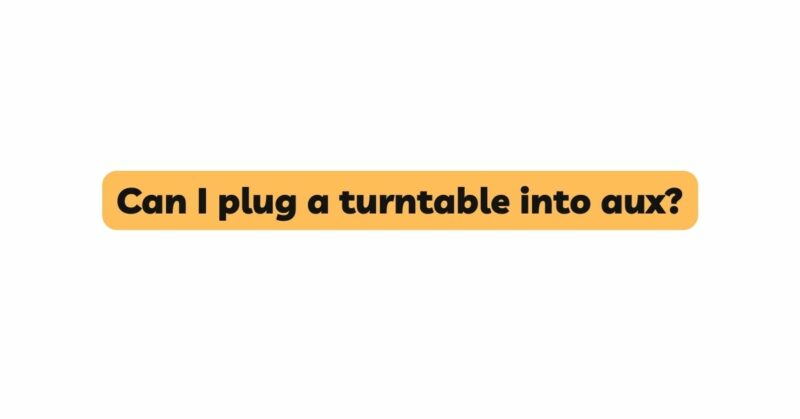The revival of vinyl records has ignited a renewed passion for analog sound, attracting both seasoned audiophiles and newcomers to the world of vinyl. As more individuals explore vinyl playback, questions arise about integrating turntables with modern audio systems. One common query is: Can I plug a turntable into the aux input? In this article, we delve into the intricacies of this connection method, examining its feasibility, benefits, potential challenges, and steps to achieve a harmonious integration that bridges the gap between analog and digital audio realms.
The Quest for Compatibility: Turntables and Aux Inputs
Turntables, revered for their authentic and immersive sound, have a unique place in the hearts of music enthusiasts. The aux (auxiliary) input, commonly found on modern audio systems, is designed to accommodate various audio sources, including smartphones, MP3 players, and external audio devices. The prospect of connecting a turntable to the aux input piques curiosity, leading to a deeper exploration of compatibility and audio quality.
Understanding the Aux Input
The aux input, often labeled as “AUX IN” or “Line In,” serves as a versatile entry point for external audio sources. It accepts line-level signals, which are compatible with devices that produce a standardized level of audio output. However, turntables produce a weaker signal known as “phono level.” This distinction introduces the need for additional components to bridge the gap between turntables and aux inputs.
The Challenges of Direct Connection
- Signal Mismatch:
Turntables output a phono-level signal, which is considerably weaker than the line-level signal expected by aux inputs. Plugging a turntable directly into an aux input typically results in low audio volume and insufficient signal amplification.
- Need for Preamp:
To amplify the turntable’s phono-level signal to line level, a phono preamp (also known as a phono stage) is essential. This component enhances the signal, ensuring compatibility with aux inputs.
- Equalization (RIAA):
Vinyl records are cut with a specific equalization curve known as the RIAA curve. A phono preamp not only boosts the signal but also corrects the equalization, resulting in accurate and balanced sound.
The Phono Preamp Solution
A phono preamp serves as the crucial intermediary between a turntable and an aux input. It amplifies the phono-level signal, applies the necessary equalization correction, and outputs a line-level signal compatible with aux inputs. Phono preamps are available as standalone units or integrated into some turntables. Connecting a turntable to the aux input involves:
- Plugging the Turntable into the Phono Preamp:
Connect the turntable’s RCA cables to the phono preamp’s input jacks, ensuring proper channel alignment.
- Connecting the Phono Preamp to the Aux Input:
Use another set of RCA cables to connect the phono preamp’s output to the aux input of your audio system.
Benefits and Considerations
Benefits of connecting a turntable to the aux input:
- Simplicity and Versatility:
Utilizing the aux input offers a straightforward connection method that doesn’t require additional components like receivers or dedicated phono inputs.
- Modern System Integration:
By using the aux input, you can seamlessly integrate a turntable into a modern audio system without the need for specialized inputs.
- Cost-Effectiveness:
If you already have a turntable and an audio system with an aux input, adding a phono preamp is a cost-effective solution compared to investing in a dedicated receiver or integrated amplifier.
Considerations:
- Phono Preamp Quality:
The quality of the phono preamp significantly influences audio fidelity. Investing in a high-quality preamp can enhance the overall listening experience.
- Speaker Impedance Matching:
Ensure that the speaker impedance matches your amplifier’s specifications to prevent overloading and distortion.
- Signal Path and Noise:
Adding extra components to the signal path can introduce noise or interference. Quality cables and proper grounding help mitigate these issues.
Conclusion
The question of whether you can plug a turntable into an aux input unveils a realm of possibilities for vinyl enthusiasts and modern audio setups. With the inclusion of a phono preamp, this integration method bridges the gap between the analog world of vinyl playback and the convenience of modern audio systems. By understanding the importance of signal matching, the role of phono preamps, and the nuances of equalization, you can achieve a seamless connection that honors the authenticity of vinyl sound while embracing the versatility of aux inputs.
As technology continues to evolve, audio enthusiasts are presented with a canvas on which to paint their sonic preferences. Whether you’re a seasoned audiophile or a newcomer to vinyl, the integration of turntables with aux inputs demonstrates the dynamic nature of the audio landscape, where the past and the present coalesce in harmonious resonance.


